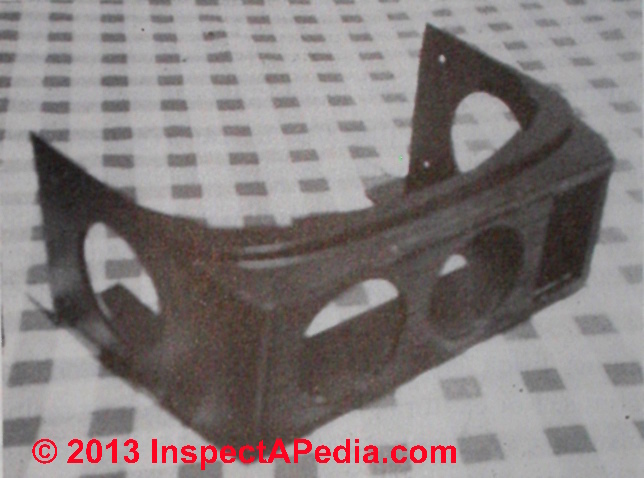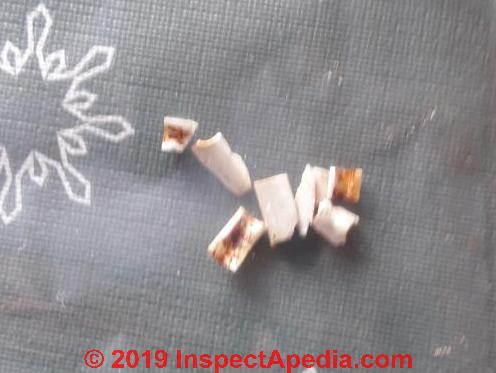 Asbestos Plastic Components & Ingredients
Asbestos Plastic Components & Ingredients
Manufacture of Asbestos Containing Plastics & Molded Materials
- POST a QUESTION or COMMENT about what building materials may contain asbestos, visual identification of asbestos-containing materials in buildings, and possible asbestos material identification by testing, use, age, appearance
Basic components used in asbestos based formed or molding products: this article series about asbestos plastics & molded materials describes the history, manufacturing process & uses of asbestos plastics and molded materials such as asbestos reinforced handles, the Vanguard rocked nose cone, automobile parts & housings, electronic equipment (radar scanner), asbestos-filled Teflon, rocket motor parts, plastic drop tanks for the Hawker Sea Hawk, and hundreds of other products.
InspectAPedia tolerates no conflicts of interest. We have no relationship with advertisers, products, or services discussed at this website.
- Daniel Friedman, Publisher/Editor/Author - See WHO ARE WE?
Asbestos Plastic Components & Makeup
How Asbestos Fabrics & Fillers Were Combined with Phenolics to Form Molded Plastic Products
By the use of asbestos fillers, phenolics can be made into many standard forms to meet the design requirements of high-impact strength, tensile strength, electrical insulating qualities, heat resistance, chemical resistance, moisture resistance, and wear resistance.
Figure 9.3. Automobile air-conditioning housing made of polyester premix compound containing 55 per cent asbestos. - Courtesy Houston Reinforced Plastics Co. [Click to enlarge any image]
For laminated or molded items, asbestos fabrics, papers, felts, mats, loose fibers and yarns are used.
The fabrics used are generally of heavy construction and low cost which meet National Electrical Manufacturing Association (NEMA) requirements.
The asbestos papers used for combination with phenolics include low-cost, low-strength paper products as well as such specialty paper products as Quinterra* and Novabestos.**
* Johns-Manville Corp.
** Raybestos-Manhattan, Inc.
The specialty grade papers, which are also more expensive, have been developed specifically for rigid electrical requirements. Table 9.2 provides for general information concerning asbestos felts.
| TABLE 9.2. Properties of Standard Asbestos Felts | ||
|---|---|---|
| Asbestos Felt Style A |
Asbestos Felt Style U |
|
Thickness (based on height of 10
plies), in. ± 10 % |
0.010 | 0.010 |
Weight per 100 sq ft, lb, ± 5% |
2.0 | 1.8 |
ASTM Grade ( D375-52) |
AAAA | Underwriters |
Asbestos fiber contained in the felt,
% min |
99 | 80 |
Organic content,
% max |
1 | 20 |
Notes to the table above
Significant data for modern readers is that the asbestos content in these felt product ranges from 80% t0 99%! - Ed.
In molding compounds, short asbestos fibers such as "shorts and floats" can produce attractive surface finishes and satisfactory molding properties. Long asbestos fibers tend not to produce highly attractive surface finishes and have inferior flowing characteristics. To remedy these problems, shorter asbestos fibers are generally mixed with the long fibers.
Increasing filler content increases the viscosity of the resin systems. For example an unfilled polyester resin system with a viscosity of 2,500 centipoises at 75°F would increase to 60,000 centipoises with 20 per cent asbestos filler. Actually thick and stiff putties or pastes can be made with a high percentage of asbestos fillers in the various resin systems.
In many of the past applications, asbestos reinforced or filled plastics were not evaluated as basically structural materials. However, in the past decade there have been tremendous strides with regard to reporting and developing high strength and high modulus asbestos base plastics by industry. These types of plastics are gradually entering into such diversified fields as automotive parts, electronic parts, chemical equipment, aircraft, and missiles.
Note: significant data for modern readers is that the asbestos content in these felt product ranges from 80% t0 99%! - Ed.
See also VULCANIZED RUBBER & ASBESTOS PRODUCTS
Question: was asbestos used in the plastic coating on bicycle baskets?
My mother refurbished this weekend an old bicycle basket (age unknown). It was made of steel coated with relatively thick, plastic-like material (perhaps about 1-2 mm thick, and a good deal of visible rust through the coating). She scraped off this "plastic" with a metal scraper, and then painted the basket (picture of freshly painted basket attached).
I don't know which year the basket was manufactured. I came to think that such coating might contain mixed-in asbestos. Is that probable?
The scrap is now under the terrace tables at our cabin. The children use to play on the terrace in the summer. It was hard to get to under the terrace, but we have collected some of the scrap pieces, see attached picture.
- Anonymous by private email 1 July 2019
Reply: research on use of asbestos and asbestos waste as filler in plastics and plastic coatings
Use of asbestos in the plastic used to coat wires such as bicycle baket is not an application that I've come across, but asbestos was used in some plastic coatings - probably for more demanding and more critical applications.
The primary use of a bicycle basket plastic coating is to resist rust and corrosion.
A Google Scholar search for that application of asbestos did not produce any findings.
However a patent search does find applications in which plastic was modified by adding asbestos. Take particular note of Aldo 1954 and Greider 1944.
- Aldo, Castellani. "Continuous plastic waterproof coating in bituminous glass asbestos for buildings and application process thereof." U.S. Patent 2,695,257, issued November 23, 1954.
- Duffy, James J. "Metal plating of substrates." U.S. Patent 3,620,834, issued November 16, 1971.
Excerpt: ... can be used in the unfilled condition, or with fillers such as glass fiber, glass powder, glass beads, asbestos, talc and ... - Greider, Harold W., and George A. Fasold. "Plastic composition." U.S. Patent 2,354,593, issued July 25, 1944.
Excerpt:
As an example of a fibrous mineral filler suitable for use in the practice of this invention, reference may be made to the dust-like asbestos which is a by-product of the asbestos milling industry. A typical grade of this asbestos dust-like material is that which results as a by-product of the milling of asbestos rock for the recovery of asbestos fiber of ordinary commercial lengths, by the Quebec Asbestos Corp, of East Broughton, P. 6)., Canada.
The asbestos dust by-product referred to is of such finely-divided character that all will pass a 20-mesh standard testing sieve, about 85% by weight will pass a 48-mesh testing sieve, about by weight will pass a IOU-mesh testing sieve, about 50% will pass a 200 mesh testing sieve, and about 35% will pass a 325- mesh testing sieve.
This material has heretofore had no commercial use and has been regarded as worthless waste. For purposes of brevity, the particular material described by way of exemplification will be referred to as waste asbestos or asbestiform waste. The particle size range and gradation of particle size in this material are especially suitable for use in the practice of this invention. - Hartzell, Rowland S., and Gene Gerek. "Asbestos-foam laminates." U.S. Patent 3,522,140, issued July 28, 1970.
Excerpt: The product can be adhered to various wood, metal or plastic substrates to provide … 1. A coated asbestos-foam laminate comprising asbestos sheet material coated on one major - Michaels, Alan Sherman. "Coated asbestos and method of making and using same." U.S. Patent 3,519,594, issued July 7, 1970. in citing other patents:
Excerpt: ... Coupling agents for chrysotile asbestos and thermoplastic …
- 1976-01-27, Lion Yushi Kabushiki Kaisha, Process for preparing plastic coated metal powders …
- 1982-09-02, 1992-12-15, Union Carbide Chemicals & Plastics Technology Corporation
- Xanthos, M., and R. T. Woodhams. "Polymer encapsulation of colloidal asbestos fibrils." Journal of Applied Polymer Science 16, no. 2 (1972): 381-394.
...
Continue reading at ASBESTOS PLASTIC PROPERTIES or select a topic from the closely-related articles below, or see the complete ARTICLE INDEX.
Or see these
Recommended Articles
- ASBESTOS PLASTIC COMPONENTS
- ASBESTOS PLASTIC ELECTRICAL PROPERTIES
- ASBESTOS PLASTIC MOLDING COMPOUNDS
- ASBESTOS PLASTIC PROPERTIES
- ASBESTOS in PLASTICS - p. 142-177 in Rosato
- VULCANIZED RUBBER & ASBESTOS PRODUCTS
Suggested citation for this web page
ASBESTOS PLASTIC COMPONENTS at InspectApedia.com - online encyclopedia of building & environmental inspection, testing, diagnosis, repair, & problem prevention advice.
Or see this
INDEX to RELATED ARTICLES: ARTICLE INDEX to ASBESTOS HAZARDS
Or use the SEARCH BOX found below to Ask a Question or Search InspectApedia
Ask a Question or Search InspectApedia
Try the search box just below, or if you prefer, post a question or comment in the Comments box below and we will respond promptly.
Search the InspectApedia website
Note: appearance of your Comment below may be delayed: if your comment contains an image, photograph, web link, or text that looks to the software as if it might be a web link, your posting will appear after it has been approved by a moderator. Apologies for the delay.
Only one image can be added per comment but you can post as many comments, and therefore images, as you like.
You will not receive a notification when a response to your question has been posted.
Please bookmark this page to make it easy for you to check back for our response.
IF above you see "Comment Form is loading comments..." then COMMENT BOX - countable.ca / bawkbox.com IS NOT WORKING.
In any case you are welcome to send an email directly to us at InspectApedia.com at editor@inspectApedia.com
We'll reply to you directly. Please help us help you by noting, in your email, the URL of the InspectApedia page where you wanted to comment.
Citations & References
In addition to any citations in the article above, a full list is available on request.
- [1] ASBESTOS HISTORY & PROPERTIES [Book online] D.V. Roasato, engineering consultant, Newton MA, Reinhold Publishing Co., NY, 1959, Library of Congress Catalog No. 59-12535. We are in process of re-publishing this interesting text. Excerpts & adaptations are found in InspectApedia.com articles on asbestos history, production & visual identification in and on buildings.
- [2] "Asbestos in Plastic Compositions", A.B. Cummins, Modern Plastics [un-dated, pre 1952]
- [4] The US EPA provides a sample list of asbestos containing products epa.gov/earth1r6/6pd/asbestos/asbmatl.htm
- [5] "Characterization of asbestos exposure among automotive mechanics servicing and handling asbestos-containing materials", Gary Scott Dotson, University of South Florida, 1 June 2006, web search 3/9/2012 original source: scholarcommons.usf.edu/cgi/viewcontent.cgi?article=3505&context=etd [copy on file as /hazmat/Automotive_Asbestos_Exposure.pdf ].
- [7] Asbestos products and their history and use in various building materials such as asphalt and vinyl flooring includes discussion which draws on ASBESTOS, ITS INDUSTRIAL APPLICATIONS, ROSATO 1959, D.V. Rosato, engineering consultant, Newton, MA, Reinhold Publishing, 1959 Library of Congress Catalog Card No.: 59-12535 (out of print, text and images available at InspectAPedia.com).
- [8] "Handling Asbestos-Containing roofing material - an update", Carl Good, NRCA Associate Executive Director, Professional Roofing, February 1992, p. 38-43
- EPA ASBESTOS MATERIALS BAN: CLARIFICATION 1999
- Basic Information about Asbestos, US EPA, web search 08/17/2010, original source: http://www.epa.gov/asbestos/pubs/help.html
- EPA, ASBESTOS IN YOUR HOME [PDF] - U.S. EPA, Exposure Evaluation Division, Office of Toxic Substances, Office of Pesticides and Toxic Substances, U.S. Environmental Protection Agency, Washington,D.C. 20460
- In addition to citations & references found in this article, see the research citations given at the end of the related articles found at our suggested
CONTINUE READING or RECOMMENDED ARTICLES.
- Carson, Dunlop & Associates Ltd., 120 Carlton Street Suite 407, Toronto ON M5A 4K2. Tel: (416) 964-9415 1-800-268-7070 Email: info@carsondunlop.com. Alan Carson is a past president of ASHI, the American Society of Home Inspectors.
Thanks to Alan Carson and Bob Dunlop, for permission for InspectAPedia to use text excerpts from The HOME REFERENCE BOOK - the Encyclopedia of Homes and to use illustrations from The ILLUSTRATED HOME .
Carson Dunlop Associates provides extensive home inspection education and report writing material. In gratitude we provide links to tsome Carson Dunlop Associates products and services.



